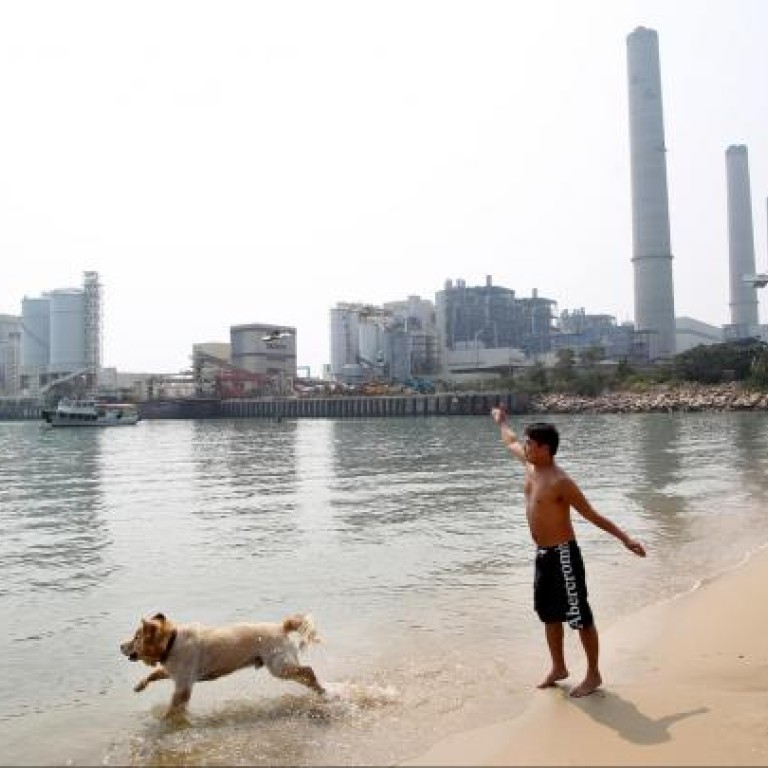
Lamma power station's three chimneys cast long shadows
Lamma may still be partitioned from its power station, but recent tragedy has made Hongkong Electric an even closer neighbour
Lamma is used to the paradox: a pristine setting devoid of chain stores that also happens to be the site of a power station responsible for illuminating Hong Kong Island.
To most of Lamma's residents, particularly those living in the settlement on the north, at Yung Shue Wan, Hongkong Electric has been little more than three tall chimneys. These dominate the island's skyline, rising from a cordoned-off peninsula that may be part of the island but is, in the words of one Lamma-ite, "sort of separate".
That changed dramatically earlier this month, when a launch owned by the power company collided with a Lamma ferry, killing 39 people on the National Day holiday.
Few islanders have much to do with the power station, and none of those who died in the October 1 accident lived on Lamma. However, Lamma has nevertheless embraced its neighbour's pain as their own.
A 75-year-old woman who has lived on Lamma ever since she was born there, and who wished to be identified only as Cheng, said the disaster had saddened her deeply. "We are the same island; I know some people living here who have worked at Hongkong Electric after they built the plant."
According to the 2011 census, the sleepy community - lumped for statistical purposes with Po Toi Island and including the settlement of Mo Tat Wan in the south - has a population of 6,013, the smallest of the outlying islands. Apart from last year's murder of a British woman, Lamma rarely makes the headlines. Petty crime is rare.
"I never lock the house door," said Tony Chan Chi-wai, a 36-year-old telecommunications worker who moved to the island a year ago with his girlfriend.
While condolence ceremonies have been held and posters offering counselling services have been plastered all over the island, the tragedy has also shed light on the oddly familiar yet distant relations between the 3,736-megawatt power plant and the residents.
Before the crash, Lamma-Gung had already seen a gulf between the village and the company in its 72-hectare enclave complete with roads bearing such names as Precipitator Road.
"It's like a city over there, a part of the island but sort of separate," he said.
One clear distinction is that the plant permits cars and buses on its property whereas the rest of the island does not.
Lamma-Gung, who last year organised the first of what he plans to be a series of power-station tours for residents, sees another side of the company.
He tells locals that the 600 Hongkong Electric workers are just as much Lamma-ites as anyone else even if they do not live on the island, drawing attention to the company's community efforts including the planting of 2,000 trees and involvement in coastal clean-ups. It also donated HK$1 million two years ago to build a community hall - the largest recreational facility on the island - which will open this year.
Hongkong Electric said it had been conducting tours regularly for residents since 2008 through the Lamma (North) Rural Committee and Lamma-Gung which have been joined by 300 people. The power plant's presence is also appreciated as a lifesaver - it is home to the only helicopter pad on the island, which is available to residents in medical emergencies.
Ron Yiu Kin-yu, a 16-year resident and owner of vegetarian eatery Green Cottage, says he has made use of the plant's helipad four times, including once to take his wife to give birth in hospital. But bakery owner Jacky Nam Shuk-yee said it was difficult to befriend Hongkong Electric employees because the company operated its own ferry to Ap Lei Chau, separate from the services used by residents.
Lamma-Gung said the gated power plant was starkly different from the rest of the island.
"Lamma is for people who aren't afraid of snakes, wasps, unleashed dogs and dog poo everywhere," he said.
Thomas Lim, a 29-year-old former resident, signed up for a visit to the plant early this year and was impressed. He said the tour included a visit to the mountainous supply of coal ready to generate most of Hong Kong Island's electricity. The tour guide had fielded questions from residents on air quality and the development of renewable energy sources such as solar and wind power.
The plant has become such a part of the island's scenery that it has given its name to a popular hangout spot - Power Plant Beach. This is right next to the power station where locals walk, canoe or sail dragon-boats as the mammoth machinery hums in the background.
Lim said the term "pollution scenery" was apt. Locals prefer this beach over the government-operated Hung Shing Yeh Beach because tourists abounded and dogs were banned there.
"A lot of people think it's very weird. If the power station wasn't there in the beginning and all of a sudden they wanted to build this, of course, I would oppose it. But as long as they keep the pollution away, I think it's OK," Lim said.
Jacky Nam said one evening, she was hiking on the Lamma Island Family Trail going towards Yung Shue Wan.
"It was pitch black everywhere and I looked down to see all the lights from the power plant. It looked like Gotham City in - beautiful in a strange way."
